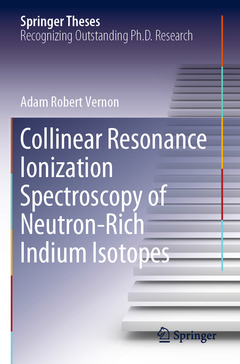Description
Collinear Resonance Ionization Spectroscopy of Neutron-Rich Indium Isotopes, 1st ed. 2020
Springer Theses Series
Author: Vernon Adam Robert
Language: English
Subject for Collinear Resonance Ionization Spectroscopy of...:
Approximative price 105.49 €
In Print (Delivery period: 15 days).
Add to cartPublication date: 11-2021
223 p. · 15.5x23.5 cm · Paperback
Approximative price 105.49 €
In Print (Delivery period: 15 days).
Add to cartPublication date: 11-2020
223 p. · 15.5x23.5 cm · Hardback
Description
/li>Contents
/li>Comment
/li>
This allowed determination of the root-mean-square nuclear charge radii, nuclear magnetic dipole moments, nuclear electric quadrupole moments and nuclear spins of the 113-131In isotopes with high accuracy.
With a proton hole in the Z = 50 nuclear shell closure of tin and several nuclear isomer states, these measurements of the indium (Z = 49) isotope chain provided an efficient probe of the evolution of nuclear structure properties towards and at the doubly-magic nuclear shell closure of 132Sn (N = 82) - revealing unpredicted changes.
Nominated as an outstanding Ph.D. thesis by the University of Manchester, Manchester, United Kingdom
Measurements of fundamental electromagnetic observables of the most exotic neutron-rich indium (Z = 49) isotopes to-date using highly sensitive laser spectroscopy techniques
Probes changes in nuclear structure in the doubly-magic 132Sn region




